EcoFlow offers a great range of portable power stations, but which can run a laptop, and is there a best one?
All EcoFlow portable power stations can run a laptop. However, the run-time will depend on the battery and the required output to power the laptop. The smallest EcoFlow RIVER 2 will run an average laptop for 2 hours 55 minutes or charge it almost 3 times, while the DELTA Pro will last over 50 hours or charge it 50 times.
As the name suggests, Portable Power Stations are portable and ideal for a laptop wherever you are. But which one would be best for your laptop?
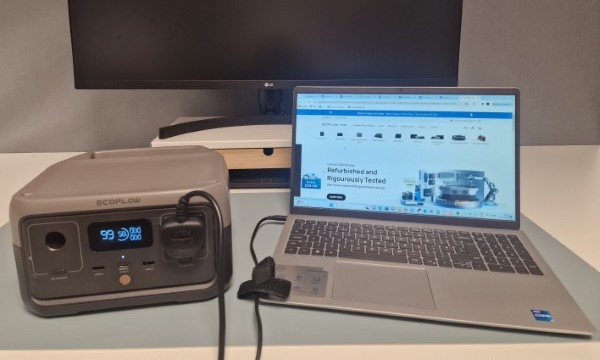
Table of contents
While different laptops have different power needs, most will range between 20 watts and 100 watts per hour. However, higher-spec laptops, such as those built for gaming or video editing, often use a lot more (up to 300 watts per hour!). Various models of EcoFlow have varying capacities, so let's look at how long each of them will power an average 50W laptop.
50w Laptop
| Model |
50w laptop Runtime |
| RIVER 2 | 3 hours, 47 minutes |
| RIVER 2 Max | 7 hours, 47 minutes |
| RIVER 2 Pro | 11 hours, 31 minutes |
| DELTA 2 | 16 hours, 35 minutes |
| DELTA 2 Max | 36 hours, 27 minutes |
| DELTA Pro | 65 hours, 31 minutes |
While this is the average power consumption for a laptop, the power consumption will increase if you use it for more intensive purposes, such as gaming or video editing.
This is primarily because of the laptop's cooling features, such as increasing fan speeds to avoid overheating.
Similarly, using your laptop for simple applications, such as Microsoft products or browsing the internet, will use less power, and require less cooling.
How do you calculate how long your laptop will run?
To calculate how long your laptop will run, you will need the following:
- The battery capacity of the power station,
- the power consumption of the laptop, and,
- the power station efficiency.
To help, I built a simple calculator for each model of EcoFlow.
Alternatively, you can use the following calculation to determine how many times your Portable Power Station can charge your laptop from 0% to 100%.
Number of charges calculation
Battery capacity (watt-hours) / laptop battery capacity (watts) * Power Station efficiency (%) = number of charges
If you are unsure of the battery capacity for your laptop, use the command prompt with straightforward instructions. Follow the below steps to find out the capacity:
-
Click the start button, and open the command prompt with "Run as administrator."

-
In the command prompt type: powercfg /batteryreport. Click enter. It takes 60 seconds for the report to run. Once it has run, it will show you a file location it has been saved to, looking something like this:

-
You can locate the report and open it. Scroll down to installed batteries, and you will find the "Design Capacity" and "Full Charge Capacity". There are two ways it may look.
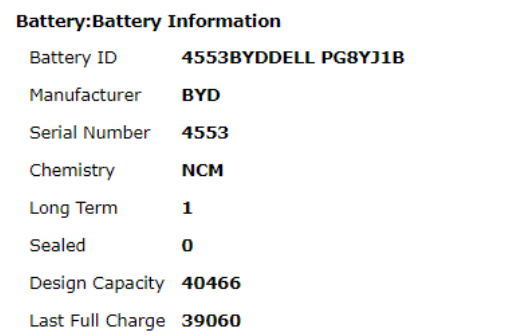
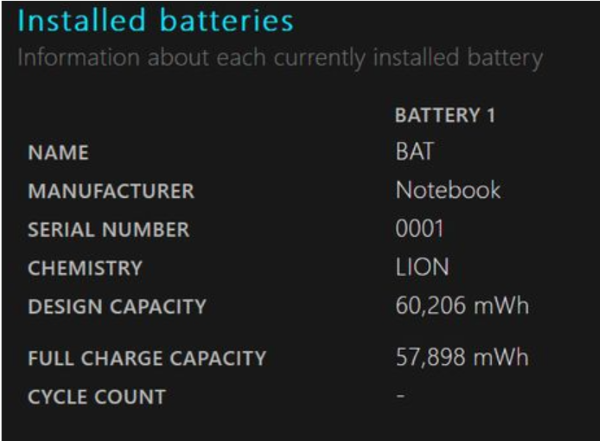
The design capacity is what the battery capacity was when the laptop was new.
The full charge capacity shows you the amount of energy the battery can now hold - this is a good indicator of your battery health. If it is much lower than the design capacity, it may be time to replace the battery or purchase a new laptop!
The capacity is written in mWh, which stands for micro-watt hours. To convert this to watt hours, which is much easier to use, divide the mWh by 1000. Use this number in the formula above to find out how many times an EcoFlow could charge your laptop.
Laptop power consumption
Most laptops will have their power consumption listed on a sticker; if you are lucky, it might give you it in watts. However, if you are like me, and your laptop doesn't show the wattage, you may have to look elsewhere or calculate it yourself. I suggest one of the following:
- Check your user manual
- Search online for your laptop specifications
- Use a watt meter
EcoFlow Power Station battery capacity
| Model |
Battery Capacity |
| RIVER 2 | 256Wh |
| RIVER 2 Max | 512Wh |
| RIVER 2 Pro | 768Wh |
| DELTA 2 | 1,024Wh |
| DELTA 2 Max | 2,048Wh |
| DELTA Pro | 3,600Wh |
Different EcoFlow portable power stations have varying efficiency, and there will also be a difference between AC (alternating current) and DC (direct current) charging.
Most laptops will need to be charged by AC, so let's look at the AC inverter efficiencies by each model:
| Model |
AC Inverter Efficiency |
| RIVER 2 | 74% |
| RIVER 2 Max | 76% |
| RIVER 2 Pro | 75% |
| DELTA 2 | 81% |
| DELTA 2 Max | 89% |
| DELTA Pro | 91% |
Some new laptops can be charged directly from DC via USB-C. If this is the case, the efficiency is typically better than charging from AC, as it does not go through the AC inverter. However, there will always be a parasitic loss with any device.
EcoFlow RIVER 2 laptop runtime and number of charges
I used a watt meter to calculate my laptop's runtime and number of charges available with the EcoFlow RIVER 2 portable power station.
Watt meters can be purchased for £10-£15, and I find them very helpful in calculating the watts needed for many devices, including laptops.
How to use a watt meter to calculate a laptop's wattage
Before writing this guide, I charged my Laptop up to 100%. I then started writing, plugging the charger into the watt meter and the EcoFlow RIVER 2. However, you can do this with other power sources, such as a wall plug socket.
I ran it for one hour, and to keep the battery topped up to 100% the entire time, it only used 12 watts. I was surprised at how little power was used.
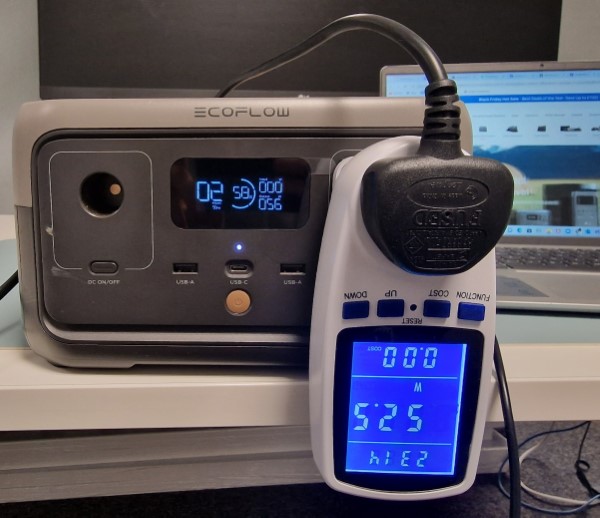
At 12 watts, the EcoFlow RIVER 2 would last an estimated 15 hours and 47 minutes or charge my laptop 15 times from 0% to 100%.
Remember, I only used a browser (Google Docs) to write this guide. If I were running an application or program, it would likely have used a lot more.
Plus, this is using an A/C adapter rather than directly from D/C, such as a USB-C (which most new laptops offer). USB-C charging is often more efficient and could increase the runtime and number of charges available. This is because it does not go through the A/C inverter, where there is always a parasitic loss.
Straight out of the box, your EcoFlow should be configured to run and charge A/C appliances, including a laptop.
But, before using your EcoFlow to power or charge your laptop, you should first charge its internal battery.
Your user guide will explain how to charge your specific power station. You can find a digital copy of the RIVER 2 user guide on the EcoFlow website here.
In general, one of the easiest ways to charge your EcoFlow will be using the included power cable or USB-C in a wall outlet tied to the grid.
Once your power station is charged, you can plug your laptop straight into the A/C or D/C outlet on the EcoFlow.
After testing several Portable Power Stations and using the RIVER 2 daily to power my laptop, I concluded that it's ideal for most.
EcoFlow RIVER 2
We recommend the RIVER 2 when choosing an EcoFlow to run and charge a laptop.
Laptops are designed to be portable, and with the RIVER 2, you get EcoFlow's lightest portable power station at a very reasonable price.
Bringing a 300W output and a 256WH battery capacity, it can run most laptops for several hours and charge them many times over.
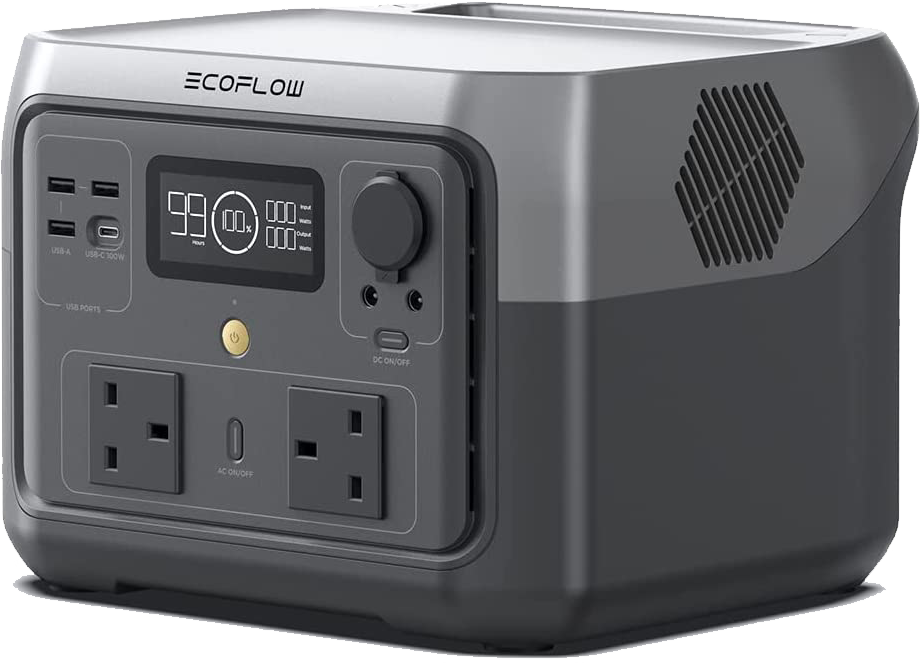
However, as it's their smallest portable power station, you might find the battery lacking if you use your laptop for more power-hungry tasks, such as video editing or gaming. If you need a portable power station to handle this, I recommend the EcoFlow RIVER 2 Max as a great portable power station for a demanding laptop.
USB-C Output
EcoFlow's portable power stations offer USB-C output, which can be really helpful for running/charging laptops. More often than ever, I see USB-C straight to USB-C, which some other power stations can't facilitate.
USB-C Charging
EcoFlow's portable power stations also offer another great feature: USB-C charging.
With Apple releasing their latest iPhone with USB-C charging, there is no question it will become the universal charger for tech.
I've also noticed that some newer hotels have USB-C for their wall charging, rather than socket plugs. Many other Portable Power Station brands are missing out on this, and their offering could become outdated before EcoFlow's.
EcoFlow makes brilliant portable power stations, all of which are more than capable of running a laptop. However, you might want to consider cheaper alternatives or other brands which offer more features for your money.
We have tested models from the leading portable power station brands, EcoFlow, Bluetti, and Jackery.
| Portable Power Station |
Inverter Power |
Battery Size |
| Bluetti EB3A |
600 watts |
268 Wh |
| EcoFlow RIVER 2 |
300 watts |
256 Wh |
| Jackery 240 |
200 watts |
240 Wh |
Based on its battery capacity, build quality and price, the EcoFlow RIVER 2 is one of the best in its class.
However, I was also very happy with the Bluetti. They are often similar in price, but the Bluetti offers a higher output, which can be helpful for running other devices.
While the Jackery is usually more expensive than the other brands and offers fewer features, it is the lightest portable power station. This can be ideal for travelling or camping. However, there is a reason it is lighter - its battery chemistry.
The Jackery 240 also takes much longer to charge than the EcoFlow RIVER 2, so unless weight was the most important factor, I would not buy the Jackery 240 over the EcoFlow RIVER 2.
You will often find EcoFlow and Ecoflow products on sale. Check out their latest prices below:
Bluetti EB3A Latest Price
EcoFlow RIVER 2 Latest Price
Jackery 240 Latest Price
A great feature that EcoFlow offer with all their portable power stations is that you can charge your battery while running or charging your laptop. This means if your battery is low on your laptop and EcoFlow, you can continue to run the laptop and charge the EcoFlow at the same time. If you are at home, you can simply plug it into a wall socket or USB-C charging port.
But what if you are on the road or don't have access to mains power?
Three other great ways to keep your power station charged are:
- Solar power
- DC power
- USB-C Charging (5/9/12/15/20V, 5A, 100W Max)
Solar power
EcoFlow works excellently with solar panels. Whether you have yours hard mounted on the roof of your house or portable for camping, using the sun's rays to charge your battery is a great way to boost performance.
While EcoFlow sells solar panels specifically for their power stations, they can be expensive compared to others on the market. However, they come with all the necessary adaptors for your portable power station and are easy to set up straight from the box.
EcoFlow 110W Solar Panel
EcoFlow's 110W Solar Panel is compatible with most of their portable power stations, including the RIVER 2, which I recommend to run/charge a laptop.
EcoFlow's RIVER 2 (recommended) portable power station doesn't come with any solar connectors. Therefore, if you are using your own solar panels, you must purchase an XT60 or XT60i to MC4 adaptor.
However, their larger models, including the RIVER 2 Max, come with a solar charge cable pre-terminated to MC4, a widespread solar connector. (DC5521)
But, if you use your own solar panels, be careful; you must ensure that they are within the specifications of your EcoFlow.
Important!
Ensure you refer to the owner's guide, which will tell you the Open Current Voltage (OCV), maximum input current, and maximum input power.
Do not exceed these parameters, or you will damage your power station!
For example, the RIVER 2 has a maximum solar input of 110W (11-30V, 8A).
DC power
Powering by another DC battery is one of my favourite ways to add extra battery capacity cheaply!
My setup allows me to more than double my battery capacity for much less than buying the next model up.

This allows me to charge my EcoFlow RIVER 2 at 95W, which is more than enough to extend the battery on the RIVER 2 while running a laptop.
As you can see, unlike some other portable power stations, EcoFlow provides a digital display telling me exactly how long it has left to run.
To replicate, you will need the following:
- 12V battery
- 12V to 19V 5A step-up converter
- XT60i pigtail. However, I could not find any reasonably priced ones that would ship from the UK. Therefore, I purchased a Solar to XT60i cable, and cut it in half.
- Basic wiring tools (wire cutters, strippers, crimpers)

While powering your laptop off-grid with a portable power station is a great solution, it will only be suitable for some.
Some other alternative ways to power your laptop include:
- solar
- diesel generator
- gas (propane) generator
- UPS
To stay as green as possible, we always recommend, where possible, powering your devices using solar power.
About the author
Andy Vickery has been DIY'ing energy projects for years. From solar and home electrics, to car rewires, Andy is passionate about sharing his personal experiences.